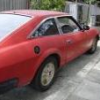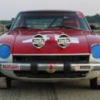My Engines
How All Started
Some time in the year 2000 my neighbor gave me a cylinder head (AB7)?
It was off a Nissan 4 cylinder L series engine.
A friend of his gave me a 1983 bluebird wagon with a faulty carbie.
I used the block out of this car for my 1983 Bluebird sedan.
In my spare time I ported this head and a manifold that I had.
In 2002 I installed the good block from the wagon and the cylinder head into my 1983 Bluebird.
It fired up ok took it for a test drive wow it was really responsive.
I had 33 cc in the chamber approx compression ratio 12.5:1
I found just by depressing accelerator to the floor I was able to create wheel slip in 2nd gear, going around a typical right-hand corner at normal speeds I was pleased.
But the timing was really out when the revs where up past 3000.
This engine had a very short life.
*
I ended up destroying this high compression engine, because of the timing characteristics that was needed to run it.
*
The strange characteristics.
I found by revving this engine with no load above 3000 Revolutions Per Minute (RPM) it made a terrible knocking/banging sound like all the bearings were not there, but the block was in good condition before.
The knocking/banging sound was constantly there when driving the RPM was over 3000 RPM.
I had plenty of power under the hammer I was pleased with my work.
The correct spark plugs for this engine would only last 3 days.
I started replacing the all the high voltage components; the result was a slight improvement but short lived.
I ended up reducing the compression ratio to 8:1 in 2002 I did know what else to do.
I had discovered a way to run a spark ignited (SI) internal combustion (IC) engine several degrees After Top Dead Center (ATDC), all thought I did not realize at the time.
*
I connected timing light and started to investigate.
I found the only way to silence the noise was to retard the timing back to 3 to 4 degrees Before Top Dead Center (BTDC) this was when the engine revs were over 3000 RPM, with no load on my engine.
With the standard mechanical advance it then caused the timing at idle to be totally wrong.
When at idle which is ~22 degrees less this engine would not idle, because it was being fired ~18 degrees After Top Dead Center (ATDC) which is extremely too late in the power cycle to achieve Peak Combustion Pressure (PCP).
I now know from my 2nd engine the vacuum advance needs be approx in an 18 degrees range.
*
*
I started to think.
I could make a computerised ignition system I had a Laptop.
I built up an interface for the printer port.
I built the first interface with 2 transistors and 2 leds 6 resistors on a piece of veroboard soldered on the end of a DB 25 way connector .
I bought 2 kits from altronics to try and tune the engine.
1 was the high-energy ignition kit and a programmable ignition controller that would allow a negative slope, however I found this was not good enough for my Engine.
I then started to write a program in BASIC, the first one was just to delay the spark.
It didn’t work very well but it did stop the knocking above 3000 RPM.I worked on the programs all night to try and overcome this timing problem.
I quickly got a program to work and have been improving it till now (7 years).
I had to grind out the locating keyway on a rotor button to allowing the timing signal to be advanced so the computer could takeover
I had to manually enter the timing every 25 RPM into data statements.
I gathered data over the next 8 months after lowering the compression to 8:1 in 2002.
My engine died and I threw out but I should of kept the head.
*
*
*
Peak combustion pressure (PCP) needs to be achieved by the time the crankshaft is 17-19 degrees ATDC according to research I have done on the Internet.
The second engine is now running with an advance is approximately 15 degrees BTDC at 3000 RPM with WOT.
The timing drops with carbon build up thus is very unstable in the long term but if it keeps going we will end up firing after top dead center (ATDC) again.
*
I’ve found on many sites From Information stated that a knocking engine will quickly destroy the pistons and bearings etc
Yet I was not able to melt my pistons even with 22-25 degrees to much advance.
My engine was run with extremely heavy knocking AT WOT up to 6500 RPM through the gears to over 120 km/h on a hwy lots of times and never melted anything,
But I was hammering the life out of the crankshaft and other parts below.
*
I would need to build a 3rd engine and do more tests.
Assuming current data would be similar in range on previous engine at Wide Open Throttle (WOT) the original head may have been timed (fired) as late as 14 degrees ATDC above 3000 RPM and still achieve Peak Combustion Pressure (PCP), it’s a rough guess at best.But it’s a slippy slope estimating timing on the down side of the power stroke when no one has done it before. *
*
After suffering many personal hardships.
I then moved to my sisters in Huntingdale and continued to improve my timing program.
*
In 2005 had the courage to start this project again.
To work a head and manifold on another L series engine.
*
I got it all together in the 3rd quarter of 2005.
Now with the second engine a mild version, the data that I have gathered it now indicates that there is approximately 30 degrees of vacuum advance, on a cold night.
*
I'm building a web site





1 Comment
Recommended Comments
Create an account or sign in to comment
You need to be a member in order to leave a comment
Create an account
Sign up for a new account in our community. It's easy!
Register a new accountSign in
Already have an account? Sign in here.
Sign In Now